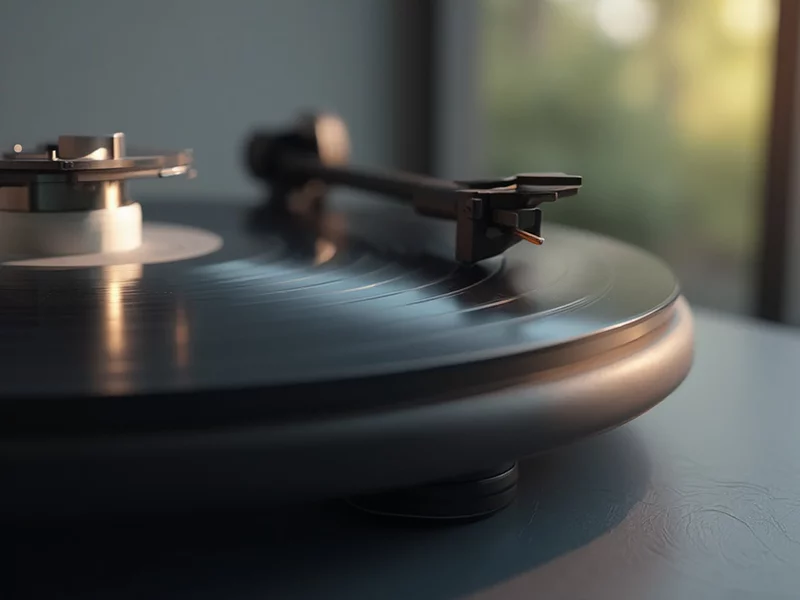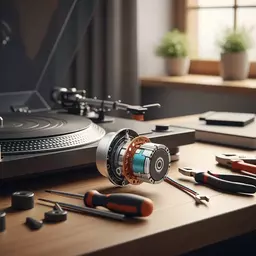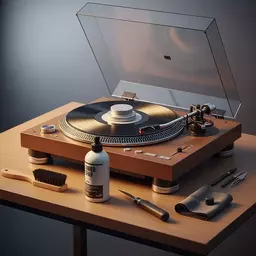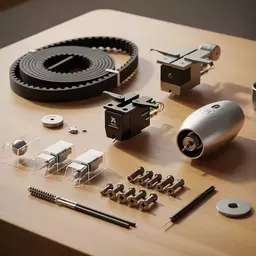Turntable Belt Replacement Signs

Ever wondered how a simple turntable belt can make or break your vinyl listening experience? Maintaining your turntable's belt is essential for an optimal sound, and in this guide, you’ll learn to spot the signs of wear before they turn into bigger issues.
What You Will Learn
- Identify visual indicators of belt wear, such as cracking and stretching.
- Recognize audio symptoms like speed fluctuations and pitch variation that signal belt issues.
- Learn how to properly check belt tension and integrity with a step-by-step guide.
- Discover the benefits of using a strobe disc for precise speed measurement on your turntable.
- Understand the recommended maintenance routine and replacement timeline for turntable belts.
Turntable Belt Issues: Symptoms, Diagnosis, and Maintenance
Troubleshooting common turntable belt problems involves recognizing both visual and audio cues, followed by systematic diagnosis and timely maintenance. Below is a summary of key indicators and essential steps to keep your turntable performing optimally.
Visual Indicators of Belt Wear
- Cracking: Splits or cracks on the surface.
- Stretching: Loss of original shape and elasticity.
- Loss of elasticity: Belt feels loose or floppy.
Regular visual checks recommended.
Audio Symptoms of Belt Issues
- Speed fluctuations: Records play faster or slower.
- Pitch variation: Noticeable changes in pitch.
- Wow and flutter: Wavering pitch, especially in vocals.
Listen closely to performance.
How to Check Belt Tension & Integrity
- Unplug turntable.
- Remove platter.
- Inspect for damage.
- Check tension (some resistance).
- Reassemble & test.
Step-by-step diagnostic process.
Using a Strobe Disc for Speed
- Acquire a strobe disc.
- Place and spin on turntable.
- Observe markings: if moving, speed is off.
Accurate speed measurement tool.
Key Maintenance Takeaways
- Check for visual signs regularly.
- Listen for audio inconsistencies.
- Replace belts every 3-5 years.
Ensuring optimal performance.
Belt Drive vs. Direct Drive
- Belt Drive: Better sound quality, reduced motor noise.
- Direct Drive: Durability, quick start-up, consistent speed (favored by DJs).
Impact on sound quality & use.
Recognizing the Symptoms of Turntable Belt Wear
As an audiophile, I know firsthand how frustrating it can be when your turntable isn’t performing at its best! One of the most common issues that can arise is belt wear. Recognizing the symptoms early on can save you time and money in repairs. Let’s explore some key signs that indicate your turntable belt may need attention.
Visual Indicators of a Worn Turntable Belt
When inspecting your turntable, look for visible signs of wear on the belt. Here are a few common indicators:
- Cracking: If you notice splits or cracks on the surface of the belt, it’s a clear sign that it’s time for a replacement.
- Stretching: Over time, belts can lose their original shape and elasticity, making them longer and less effective.
- Loss of elasticity: A belt that feels loose or floppy may not engage properly, impacting performance.
These visual cues can help you determine whether your belt is still up to the job. Remember, regular checks can keep your beloved vinyl experience free from frustration!
Audio Symptoms Indicating Belt Issues
In addition to visual checks, you should also pay attention to the audio performance of your turntable. If you hear any of these audio symptoms, your belt might be on its last legs:
- Speed fluctuations: If your records are playing faster or slower than expected, a worn belt could be the cause.
- Pitch variation: Noticeable changes in pitch during playback are often a sign that the belt is struggling to maintain consistent speed.
- Wow and flutter: This term refers to wavering pitch and can be especially annoying in vocal tracks. It’s usually a sign that your turntable belt needs attention.
Listening closely to your records can help you catch these issues early. Trust me, nothing beats the sound of a well-maintained turntable!
Diagnosing Turntable Belt Problems
Once you've identified potential issues, it’s time to diagnose the problem accurately. Understanding how to check your turntable belt properly is essential for effective repairs.
How to Check Belt Tension and Integrity
Here’s a step-by-step guide that I often recommend for assessing the condition of your turntable belt:
- Unplug your turntable for safety.
- Remove the platter to access the belt.
- Inspect the belt for any visible damage, such as cracks or stretching.
- Check the tension by gently pulling on the belt; it should have some resistance but not feel overly tight.
- Reassemble the turntable and test it to see if you notice any issues during playback.
Taking these steps can help you determine whether you need a replacement or if a little maintenance will do the trick.
Using a Strobe Disc for Accurate Speed Measurement
Using a strobe disc is a fantastic way to diagnose speed issues accurately. Here’s how you can do it:
- Get a strobe disc: These discs are specifically designed to help you measure the speed of your turntable.
- Play the disc: Place it on your turntable and let it spin.
- Observe the markings: If the markings on the disc appear to be moving, your turntable is not spinning at the correct speed.
Employing this method can significantly enhance your understanding of any speed discrepancies, allowing you to fine-tune your setup for optimal sound quality. For additional guidance on how to use a strobe disc effectively, you can check out this Sony support article on turntable speed adjustment, which provides valuable insights into maintaining accurate playback speeds.
Pro Tip
To keep your turntable belt in optimal condition, consider applying a small amount of silicone lubricant to the belt surfaces every few months. This can help maintain elasticity and reduce wear, ultimately prolonging its lifespan and ensuring smooth playback.
Summarizing Key Insights on Turntable Belt Maintenance
Maintaining your turntable belt is crucial for ensuring that your records sound their best! The importance of recognizing signs of wear cannot be overstated. A worn belt can lead to a host of audio issues that detract from the rich experience that vinyl has to offer. Remember, timely replacements and preventive care can extend the life of your turntable and enhance your listening pleasure.
- Check for visual signs like cracking or stretching.
- Listen for audio symptoms such as speed fluctuations.
- Replace belts every 3-5 years as a general guideline.
By keeping an eye (and ear) on these factors, you can ensure that your turntable continues to perform optimally. A little attention goes a long way in preserving the analog sound quality you cherish.
Taking the Next Steps for Optimal Turntable Performance
Now that you’re aware of how to recognize signs of a worn turntable belt, it’s time to take action! I encourage you to assess your turntable belts regularly. If you notice any signs of wear or hear any unusual sounds, it might be time for a replacement. Your turntable deserves the best care, and prompt action will ensure a continued quality listening experience! For those looking for suitable replacement parts, you might find this universal flat turntable belt on Amazon to be a helpful resource.
- Inspect your turntable belt for visible damage.
- Conduct an audio test to check for inconsistencies.
- Consult with Turntable Repair Australia for any replacement needs.
Taking these proactive steps will help you enjoy your vinyl collection to its fullest. Trust me; there’s nothing quite like the sound of a well-maintained turntable!
Understanding the Impact of Turntable Types on Sound Quality
When it comes to turntables, the type of drive system you choose can significantly affect sound quality. Let’s break down the differences between belt drive and direct drive systems!
- Belt Drive: Generally offers better sound quality due to reduced motor noise. The belt absorbs vibrations, providing a clearer audio signal.
- Direct Drive: Known for durability and quick start-up times. These are often favored by DJs for their robustness and consistent speed.
Many audiophiles prefer belt drive systems for their superior sound stability and vibration isolation. However, direct drive systems might appeal to those looking for versatility and ease of use. Ultimately, it comes down to your personal preference and how you intend to use your turntable. To learn more about the mechanics and history of these fascinating devices, consider exploring the Wikipedia page on turntables, which offers a comprehensive overview of their evolution and technology.
Recap of Key Points
Here is a quick recap of the important points discussed in the article:
- Regularly check your turntable belt for visual signs of wear, such as cracking or stretching.
- Listen for audio symptoms like speed fluctuations and pitch variations that indicate belt issues.
- Follow a step-by-step guide to assess belt tension and integrity properly.
- Utilize a strobe disc for accurate speed measurement to diagnose any discrepancies.
- Replace your turntable belt every 3-5 years to maintain optimal performance.
Frequently Asked Questions About Turntable Belt Maintenance
Q: What are the main visual signs that indicate a turntable belt is worn?
A: The main visual signs include cracking, stretching (loss of original shape), and a general loss of elasticity, making the belt feel loose or floppy.
Q: How can I tell if my turntable belt is affecting the audio quality?
A: Audio symptoms of a worn belt include speed fluctuations (records playing faster or slower), noticeable pitch variations, and "wow and flutter," which manifests as a wavering pitch, particularly in vocals.
Q: What is the recommended method for checking turntable belt tension?
A: To check belt tension, unplug the turntable, remove the platter, and gently pull on the belt. It should offer some resistance but not feel excessively tight or loose. Also, inspect it for any visible damage.
Q: How does a strobe disc help in diagnosing turntable speed issues?
A: A strobe disc is placed on the turntable and spun. If the markings on the disc appear to be moving under a specific light source (often LED or fluorescent), it indicates that the turntable is not spinning at the correct speed, allowing for precise speed adjustment.
Q: How often should a turntable belt be replaced?
A: As a general guideline, it is recommended to replace your turntable belt every 3-5 years to maintain optimal performance and sound quality.
Q: What is the difference between belt drive and direct drive turntables regarding sound quality?
A: Belt drive turntables generally offer better sound quality because the belt absorbs motor vibrations, leading to reduced motor noise and a clearer audio signal. Direct drive turntables, while durable and quick to start, can sometimes transfer motor noise more directly to the platter, though modern designs mitigate this.
Popular Posts
 Are you ready to elevate your turntable's performance? Understanding the nuances of motor replacemen
Are you ready to elevate your turntable's performance? Understanding the nuances of motor replacemen
 Have you ever wondered how a little maintenance can dramatically enhance your turntable's performanc
Have you ever wondered how a little maintenance can dramatically enhance your turntable's performanc
 Have you ever found yourself frustrated with a turntable that just won't play right? The good news i
Have you ever found yourself frustrated with a turntable that just won't play right? The good news i
 Have you ever considered how the condition of your tonearm affects the music you love? Proper tonear
Have you ever considered how the condition of your tonearm affects the music you love? Proper tonear
